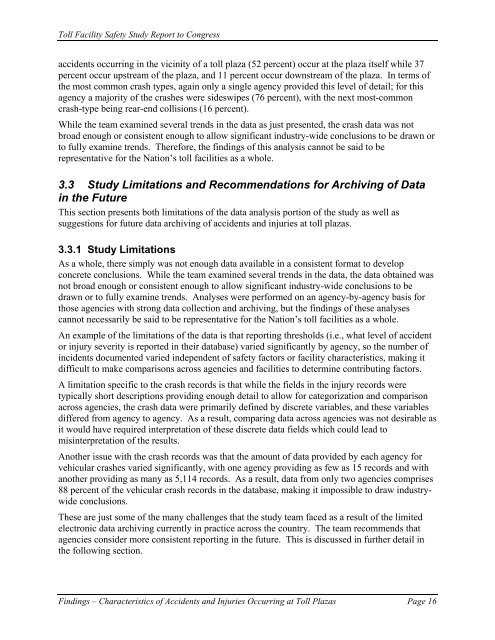Toll Facility Safety Study Report to Congress - About
Toll Facility Safety Study Report to Congress - About
Toll Facility Safety Study Report to Congress - About
Create successful ePaper yourself
Turn your PDF publications into a flip-book with our unique Google optimized e-Paper software.
<strong>Toll</strong> <strong>Facility</strong> <strong>Safety</strong> <strong>Study</strong> <strong>Report</strong> <strong>to</strong> <strong>Congress</strong><br />
accidents occurring in the vicinity of a <strong>to</strong>ll plaza (52 percent) occur at the plaza itself while 37<br />
percent occur upstream of the plaza, and 11 percent occur downstream of the plaza. In terms of<br />
the most common crash types, again only a single agency provided this level of detail; for this<br />
agency a majority of the crashes were sideswipes (76 percent), with the next most-common<br />
crash-type being rear-end collisions (16 percent).<br />
While the team examined several trends in the data as just presented, the crash data was not<br />
broad enough or consistent enough <strong>to</strong> allow significant industry-wide conclusions <strong>to</strong> be drawn or<br />
<strong>to</strong> fully examine trends. Therefore, the findings of this analysis cannot be said <strong>to</strong> be<br />
representative for the Nation’s <strong>to</strong>ll facilities as a whole.<br />
3.3 <strong>Study</strong> Limitations and Recommendations for Archiving of Data<br />
in the Future<br />
This section presents both limitations of the data analysis portion of the study as well as<br />
suggestions for future data archiving of accidents and injuries at <strong>to</strong>ll plazas.<br />
3.3.1 <strong>Study</strong> Limitations<br />
As a whole, there simply was not enough data available in a consistent format <strong>to</strong> develop<br />
concrete conclusions. While the team examined several trends in the data, the data obtained was<br />
not broad enough or consistent enough <strong>to</strong> allow significant industry-wide conclusions <strong>to</strong> be<br />
drawn or <strong>to</strong> fully examine trends. Analyses were performed on an agency-by-agency basis for<br />
those agencies with strong data collection and archiving, but the findings of these analyses<br />
cannot necessarily be said <strong>to</strong> be representative for the Nation’s <strong>to</strong>ll facilities as a whole.<br />
An example of the limitations of the data is that reporting thresholds (i.e., what level of accident<br />
or injury severity is reported in their database) varied significantly by agency, so the number of<br />
incidents documented varied independent of safety fac<strong>to</strong>rs or facility characteristics, making it<br />
difficult <strong>to</strong> make comparisons across agencies and facilities <strong>to</strong> determine contributing fac<strong>to</strong>rs.<br />
A limitation specific <strong>to</strong> the crash records is that while the fields in the injury records were<br />
typically short descriptions providing enough detail <strong>to</strong> allow for categorization and comparison<br />
across agencies, the crash data were primarily defined by discrete variables, and these variables<br />
differed from agency <strong>to</strong> agency. As a result, comparing data across agencies was not desirable as<br />
it would have required interpretation of these discrete data fields which could lead <strong>to</strong><br />
misinterpretation of the results.<br />
Another issue with the crash records was that the amount of data provided by each agency for<br />
vehicular crashes varied significantly, with one agency providing as few as 15 records and with<br />
another providing as many as 5,114 records. As a result, data from only two agencies comprises<br />
88 percent of the vehicular crash records in the database, making it impossible <strong>to</strong> draw industrywide<br />
conclusions.<br />
These are just some of the many challenges that the study team faced as a result of the limited<br />
electronic data archiving currently in practice across the country. The team recommends that<br />
agencies consider more consistent reporting in the future. This is discussed in further detail in<br />
the following section.<br />
Findings – Characteristics of Accidents and Injuries Occurring at <strong>Toll</strong> Plazas Page 16

















